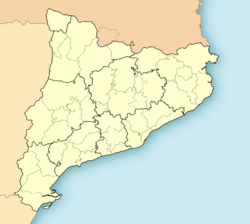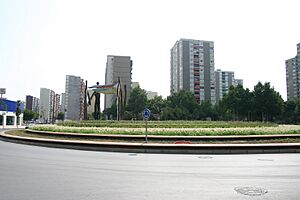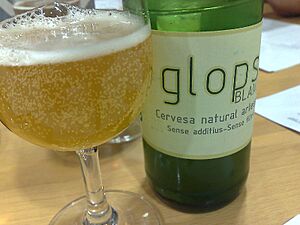L'Hospitalet de Llobregat facts for kids
Quick facts for kids
L'Hospitalet de Llobregat
|
|||
|---|---|---|---|
|
Municipality
|
|||
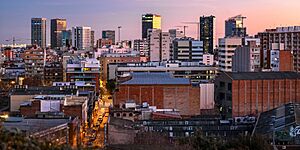 |
|||
|
|||

Location in Barcelonès county
|
|||
| Sovereign state | |||
| Community | |||
| Region | Barcelona | ||
| County | Barcelonès | ||
| Province | Barcelona | ||
| Founded | 12th century | ||
| Government | |||
| • Type | Ajuntament | ||
| • Body | Ajuntament de L'Hospitalet | ||
| Area | |||
| • City | 12.4 km2 (4.8 sq mi) | ||
| Elevation
(AMSL)
|
8 m (26 ft) | ||
| Population
(2018)
|
|||
| • City | 261,068 | ||
| • Density | 21,050/km2 (54,530/sq mi) | ||
| Demonyms | hospitalenc, -ca (ca) hospitalense (es) |
||
| Time zone | UTC+1 (CET) | ||
| • Summer (DST) | UTC+2 (CEST) | ||
| Postal code |
0890x
|
||
| Dialing code | +34 (E) 93 (B) | ||
| INE code | 08 1017 | ||
| City budget (2014) | €200 million | ||
| Main festitivity | ? | ||
| Patron saint | Saint Eulalia | ||
L'Hospitalet de Llobregat is a large city in Catalonia, Spain. People often call it L'Hospitalet or just L'H. It's part of the Barcelona metropolitan area, which is a big group of cities and towns around Barcelona.
L'Hospitalet is the second biggest city in Catalonia by population. It's also one of the most crowded cities in the European Union.
Contents
What's in a Name?
The name L'Hospitalet means 'the small hospital' in Catalan. It refers to an old hostel or guesthouse. The name of the Llobregat river was added to help tell it apart from other towns with similar names.
A Look at History
People have lived in the Llobregat river area since the Neolithic era (the New Stone Age). We know this because ancient tools and items have been found there. Roman artifacts from around 200 BC, like a funeral decoration of Medusa's head, also show that people lived here long ago.
The first written records of the city, originally called Provençana, appeared in the 10th century. By the early 1900s, about 5,000 people lived here. The city had three main areas: Centre, Sta. Eulàlia, and Collblanc. Farming was very important and successful during this time.
In 1920, a part of L'Hospitalet became part of Barcelona. After this, L'Hospitalet became a city mainly focused on factories. They made things like textiles, metal products, ceramics, and building materials.
In the 1960s and 1970s, many people moved to L'Hospitalet from other parts of Spain looking for work. The city grew very fast, but there weren't enough schools, parks, or homes for everyone. In the 1990s, the government started investing more money to build new schools, fun places, and houses.
Who Lives Here?
L'Hospitalet is home to many people from different places. In 2020, the city had 274,320 registered residents. Many were born in Catalonia, others in different parts of Spain, and a large number were born in other countries.
The city has a diverse population. In 2020, about 67,213 people were foreign citizens. The largest groups came from countries like Morocco, Bolivia, Honduras, India, and Pakistan.
City Landscape
L'Hospitalet covers an area of about 12.49 square kilometers (about 4.8 square miles). The city is built on two main types of land.
One area is called La Marina. It's flat and close to the coast, similar to parts of nearby Barcelona. The other area is called El Samontà. This part has hills and is higher up.
How the City Works
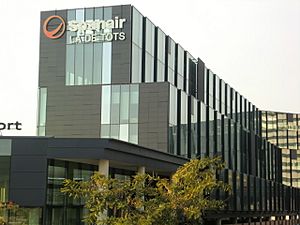
For a long time, L'Hospitalet was seen as just a working-class suburb that depended on Barcelona. However, its economy has been getting much better. You can see this from the new tall buildings and companies moving into the city's new financial area.
Over the past two decades, the city has been rebuilt and improved. There's also ongoing work to make public transportation better. For example, the former airline Spanair used to have its main office in L'Hospitalet. Leaders have worked hard to improve the city's buildings and services.
Tall Buildings
L'Hospitalet has several impressive skyscrapers. These tall buildings show how the city has grown and modernized. Some of the most notable ones include:
- Hotel Porta Fira (2010) – 113 meters (371 ft) tall
- Torre Realia BCN (2009) – 112 meters (367 ft) tall
- Hotel Catalonia Plaza Europa (2011) – 105 meters (344 ft) tall
- Hesperia Tower (2006) – 106 meters (348 ft) tall
- Torre Inbisa (2010) – 104 meters (341 ft) tall
- Torre Zenit (2009) – 104 meters (341 ft) tall
City Districts
L'Hospitalet is divided into several districts, each with its own unique feel and history.
District I
- El Centre
El Centre is the oldest part of the city and its historical heart. The City Council building is here, along with many cultural places like the History Museum and the Can Sumarro library. It's a lively area for activities and events.
- Sant Josep
Sant Josep was once a busy industrial area with factories making flour, textiles, and other goods. Over time, many factories closed, and the area became more residential. It's now a neighborhood where many people live.
- Sanfeliu
Life in Sanfeliu often happens around the Cirerers avenue and Communities Square (Plaça de les Comunitats). This square is where big celebrations like the Sant Joan festival and Carnival take place. The local cultural center also hosts many activities.
District II
- Collblanc
Collblanc is known for its many shops, especially near the Collblanc Metro station. The Market Square (Plaça del Mercat) is a central spot for shopping and cultural events.
- La Torrassa
La Torrassa has a close connection to Collblanc. Today, the Spanish Square (Plaça Espanyola) and the new La Torrassa park are important places. They are often the center of summer holiday celebrations.
District III
- Santa Eulàlia
Santa Eulàlia has roots dating back to Medieval times, with the Santa Eulàlia de Provençana hermitage from the 12th century. It was also very important during the Industrial Revolution because of its many factories.
- Gran Via Sud
This is the smallest neighborhood in L'Hospitalet.
District IV
- La Florida
La Florida is a very crowded neighborhood in Europe. It has a large number of people who have moved there from other countries.
- Les Planes
District V
- Pubilla Casas
- Can Serra
District VI
- Bellvitge
Bellvitge was built in 1964 as a residential area. It was designed to house the many people who moved to Catalonia from other parts of Spain to find work.
- Gornal
District VII
- Granvia l'Hospitalet
Getting Around
L'Hospitalet has a good public transport system, making it easy to travel around the city and to nearby Barcelona.
City Partnerships
L'Hospitalet has special partnerships with other cities around the world. These are called twin towns or sister cities. They work together on cultural and educational projects.
L'Hospitalet is twinned with:
See also
 In Spanish: Hospitalet de Llobregat para niños
In Spanish: Hospitalet de Llobregat para niños




